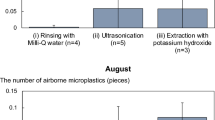Abstract
Mint leaves were dried by three different types of dryers, namely; tray, freeze and distributed (indirect)-type solar dryer. Sorption isotherms of fresh, solar, tray and freeze dried mint were determined at temperatures of 15 °C, 25 °C and 35 °C over a range of relative humidities (10–90%). The effect of drying method on the water sorption isotherms of dried mint samples was evaluated. Experimental data were used to determine the best models for predicting the moisture sorption content of mint. Among nine sorption models tested, Peleg, GAB, Lewicki and modified Mizrahi equations gave the best fit to experimental data. The sorption data were analyzed for determination of monolayer moisture content, density of sorbed water, number of adsorbed monolayers, percent bound water, and surface area of adsorbance. The experimental data were also used to determine some thermodynamic properties of mint.








Similar content being viewed by others
References
Adam E, Muhlbauer W, Esper A, Wolf W, Spiess W (2000) Effect of temperature on water sorption equilibrium of onion (Allium cepa L.). Drying Technol 18(9):2117–2129
AOAC (1990) In Official methods of analysis. Association of Official Analytical Chemists 17–18
Ayranci E, Dalgic AC (1992) Moisture sorption isotherms of Pistacia terebinthus L. and its protein isolate. Lebensm-Wiss Technol-Food Sci Technol 25:482–483
Ayranci E, Duman O (2005) Moisture sorption isotherms of cowpea (Vigna unguiculata L. Walp) and its protein isolate at 10, 20 and 30 °C. J Food Eng 70:83–91
Ayranci E, Ayranci G, Dogantan Z (1990) Moisture sorption isotherms of dried apricot, fig and raisin at 20 °C and 30 °C. J Food Sci 55:1591–1593
Basu S, Shivhare US, Mujumdar AS (2006) Models for sorption isotherms for foods: a review. Drying Technol 24:917–930
Chirife J, Iglesias HA (1978) Equations for fitting water sorption isotherms of foods. Part I. A review. J Food Technol 13:159–174
Ekechukwu OV (1999) Review of solar-energy drying systems I: an overview of drying principles and theory. Energy Convers Manage 40:593–613
Ekechukwu OV, Norton B (1999) Review of solar-energy drying systems II: an overview of solar drying technology. Energy Convers Manage 40:615–655
Hossain MD, Bala BK, Hossain MA, Mondol MRA (2001) Sorption isotherms and heat of sorption of pineapple. J Food Eng 48:103–107
Iglesias HA, Chirife J, Viollaz P (1976) Thermodynamics of water vapor sorption by sugar beet root. J Food Technol 11:91–101
Karel M (1975) Water activity and food preservation. In: Karel M, Fennema OR, Lund DB (eds) Physical principles of food preservation. Principles of food science, part 2. Marcel Dekker, Inc, New York, pp 237–263
Kouhila M, Belghit A, Daguenet M, Boutaleb BC (2001) Experimental determination of the sorption isotherms of mint (Mentha viridis), sage (Salvia officinalis) and verbena (Lippia citriodora). J Food Eng 47:281–287
Labuza TP (1984) Moisture sorption: practical aspects of isotherm measurement and use. American Association of Cereal Chemists, St Paul
Lee JH, Lee MJ (2008) Effect of drying method on the moisture sorption isotherms for Inonotus obliquus mushroom. Lebensm-Wiss Technol-Food Sci Technol 41:1478–1484
Lefler JE (1955) The enthalpy-entropy relationship and its implication for organic chemistry. J Org Chem 20:1202–1230
Lomauro CJ, Bakshi AS, Labuza TP (1985a) Evaluation of food moisture sorption equations; part I: fruit, vegetable and meat products. Lebensm-Wiss Technol-Food Sci Technol 18:111–117
Lomauro CJ, Bakshi AS, Labuza TP (1985b) Evaluation of food moisture sorption equations; part II: milk, coffee, tea, nuts, oilseeds, spices and starchy foods. Lebensm-Wiss Technol-Food Sci Technol 18:118–124
McMinn WAM, Magee TRA (2003) Thermodynamic properties of moisture sorption of potato. J Food Eng 60:157–165
McMinn WAM, Al-Muhtaseb AH, Magee TRA (2005) Enthalpy–entropy compensation in sorption phenomena of starch materials. Food Res Int 38:505–510
Mohamed LA, Kouhila M, Jamali A, Lahsasni S, Mahrouz M (2005) Moisture sorption isotherms and heat of sorption of bitter orange leaves (Citrus aurantium). J Food Eng 67:491–498
Moore WJ (1972) Physical chemistry. Longman, London
Okubayashi S, Griesser UJ, Bechtold T (2004) A kinetic study of moisture sorption and desorption on lyocell fibers. Carbohydr Polym 58:293–299
Park KJ, Vohnikova Z, Brod FPR (2002) Evaluation of drying parameters and desorption isotherms of garden mint leaves (Mentha crispa L.). J Food Eng 51:193–199
Peleg M (1993) Assessment of a semi-empirical four parameter general model for sigmoid moisture sorption isotherms. J Food Process Eng Conn USA 16(1):21–37
Rao KJ, Dhas PHA, Emerald FME, Ghosh BC, Balasubramanyam BV, Kulkarni S (2006) Moisture sorption characteristics of chhana podo at 5 °C and 35 °C. J Food Eng 76:453–459
Rizvi SSH, Benado AL (1984) Thermodynamic properties of dehydrated foods. Food Technol :83–92, March
Rosa GS, Moraes MA, Pinto LAA (2010) Moisture sorption properties of chitosan LWT. Food Sci Technol 43:415–420
Singh RRB, Rao KH, Anjaneyulu ASR, Patil GR (2006) Water desorption characteristics of raw goat meat: effect of temperature. J Food Eng 75:228–236
Sinija VR, Mishra HN (2008) Moisture sorption isotherms and heat of sorption of instant (soluble) green tea powder and green tea granules. J Food Eng 86:494–500
Soysal Y, Öztekin S (2001) Sorption isosteric heat for some medicinal and aromatic plants. J Agric Eng Res 78(2):159–166
Telis VRN, Gabas AL, Menegalli FC, Telis-Romero J (2000) Water sorption thermodynamic properties applied to persimmon skin and pulp. Thermochim Acta 343:49–56
Timoumi S, Zagrouba F (2005) Water sorption and dehydration kinetics of Tunisian rosemary leaves. Desalination 185:517–521
Tsami E, Krokida MK, Drouzas AE (1998) Effect of drying method on the sorption characteristics model fruit powders. J Food Eng 38:381–392
Tsimidou M, Biliaderis CG (1997) Kinetic studies of saffron (Crocus sativus L) quality deterioration. J Agric Food Chem 45(8):2890–2898
Whfoods (2006) The world’s healthiest foods. Peppermint, fresh; In depth nutrient analysis. http://www.whfoods.com/genpage.php?tname=nutrientprofile&dbid=115, June
Acknowledgements
This work was supported by The Research Fund of Gaziantep University.
Author information
Authors and Affiliations
Corresponding author
Rights and permissions
About this article
Cite this article
Dalgıç, A.C., Pekmez, H. & Belibağlı, K.B. Effect of drying methods on the moisture sorption isotherms and thermodynamic properties of mint leaves. J Food Sci Technol 49, 439–449 (2012). https://doi.org/10.1007/s13197-011-0302-7
Revised:
Accepted:
Published:
Issue Date:
DOI: https://doi.org/10.1007/s13197-011-0302-7




